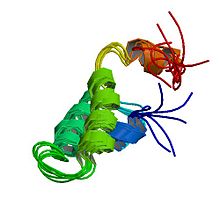- Chaperone DnaJ
-
DnaJ domain 
PDB rendering based on 1hdj. Identifiers Symbol DnaJ Pfam PF00226 InterPro IPR001623 PROSITE PDOC00553 SCOP 1xbl CDD cd06257 Available protein structures: Pfam structures PDB RCSB PDB; PDBe PDBsum structure summary DnaJ central domain Identifiers Symbol DnaJ_CXXCXGXG Pfam PF00684 Pfam clan CL0518 InterPro IPR001305 PROSITE PDOC00553 SCOP 1exk Available protein structures: Pfam structures PDB RCSB PDB; PDBe PDBsum structure summary DnaJ C terminal domain 
the crystal structure of hsp40 ydj1 Identifiers Symbol DnaJ_C Pfam PF01556 InterPro IPR002939 PROSITE PDOC00553 SCOP 1exk Available protein structures: Pfam structures PDB RCSB PDB; PDBe PDBsum structure summary In molecular biology, chaperone DnaJ, also known as Hsp40 (heat shock protein 40 kD), is a molecular chaperone protein. It is expressed in a wide variety of organisms from bacteria to humans.[1][2]
Contents
Function
Molecular chaperones are a diverse family of proteins that function to protect proteins from irreversible aggregation during synthesis and in times of cellular stress. The bacterial molecular chaperone DnaK is an enzyme that couples cycles of ATP binding, hydrolysis, and ADP release by an N-terminal ATP-hydrolizing domain to cycles of sequestration and release of unfolded proteins by a C-terminal substrate binding domain. Dimeric GrpE is the co-chaperone for DnaK, and acts as a nucleotide exchange factor, stimulating the rate of ADP release 5000-fold.[3] DnaK is itself a weak ATPase; ATP hydrolysis by DnaK is stimulated by its interaction with another co-chaperone, DnaJ. Thus the co-chaperones DnaJ and GrpE are capable of tightly regulating the nucleotide-bound and substrate-bound state of DnaK in ways that are necessary for the normal housekeeping functions and stress-related functions of the DnaK molecular chaperone cycle.
This family of proteins contain a 70 amino acid consensus sequence known as the J domain. The J domain of DnaJ interacts with Hsp70 heat shock proteins.[4] DnaJ heat-shock proteins play a role in regulating the ATPase activity of Hsp70 heat-shock proteins.[5][6]
Besides stimulating the ATPase activity of DnaK through its J-domain, DnaJ also associates with unfolded polypeptide chains and prevents their aggregation.[7] Thus, DnaK and DnaJ may bind to one and the same polypeptide chain to form a ternary complex. The formation of a ternary complex may result in cis-interaction of the J-domain of DnaJ with the ATPase domain of DnaK. An unfolded polypeptide may enter the chaperone cycle by associating first either with ATP-liganded DnaK or with DnaJ. DnaK interacts with both the backbone and side chains of a peptide substrate; it thus shows binding polarity and admits only L-peptide segments. In contrast, DnaJ has been shown to bind both L- and D-peptides and is assumed to interact only with the side chains of the substrate.
Domain architecture
Proteins in this family consist of three domains. The N-terminal J domain (described above). A central cysteine-rich region, which contains four repeats of the motif CXXCXGXG where X is any amino acid. The isolated cysteine rich domain folds in zinc dependent fashion. Each set of two repeats binds one unit of zinc. Although this domain has been implicated in substrate binding, no evidence of specific interaction between the isolated DNAJ cysteine rich domain and various hydrophobic peptides has been found.[8] A C-terminal domain, the function of which is unknown.
Human proteins containing a DnaJ domain
DNAJA1; DNAJA2; DNAJA3; DNAJA4; DNAJB1; DNAJB11; DNAJB13; DNAJB4; DNAJB5; MST104;
References
- ^ Qiu XB, Shao YM, Miao S, Wang L (November 2006). "The diversity of the DnaJ/Hsp40 family, the crucial partners for Hsp70 chaperones". Cellular and molecular life sciences : CMLS 63 (22): 2560–70. doi:10.1007/s00018-006-6192-6. PMID 16952052.
- ^ Caplan AJ, Cyr DM, Douglas MG (June 1993). "Eukaryotic homologues of Escherichia coli dnaJ: a diverse protein family that functions with hsp70 stress proteins". Molecular biology of the cell 4 (6): 555–63. PMC 300962. PMID 8374166. http://www.pubmedcentral.nih.gov/articlerender.fcgi?tool=pmcentrez&artid=300962.
- ^ Douglas MG, Cyr DM, Langer T (1994). "DnaJ-like proteins: molecular chaperones and specific regulators of Hsp70". Trends Biochem. Sci. 19 (4): 176–181. PMID 8016869.
- ^ Hennessy F, Nicoll WS, Zimmermann R, Cheetham ME, Blatch GL (July 2005). "Not all J domains are created equal: implications for the specificity of Hsp40-Hsp70 interactions". Protein science : a publication of the Protein Society 14 (7): 1697–709. doi:10.1110/ps.051406805. PMC 2253343. PMID 15987899. http://www.pubmedcentral.nih.gov/articlerender.fcgi?tool=pmcentrez&artid=2253343.
- ^ Fan CY, Lee S, Cyr DM (2003). "Mechanisms for regulation of Hsp70 function by Hsp40". Cell stress & chaperones 8 (4): 309–16. doi:10.1379/1466-1268(2003)008<0309:MFROHF>2.0.CO;2. PMC 514902. PMID 15115283. http://www.pubmedcentral.nih.gov/articlerender.fcgi?tool=pmcentrez&artid=514902.
- ^ Ohtsuka K, Hata M (2000). "Molecular chaperone function of mammalian Hsp70 and Hsp40--a review". International journal of hyperthermia : the official journal of European Society for Hyperthermic Oncology, North American Hyperthermia Group 16 (3): 231–45. PMID 10830586.
- ^ Christen P, Han W (2004). "cis-Effect of DnaJ on DnaK in ternary complexes with chimeric DnaK/DnaJ-binding peptides". FEBS Lett. 563 (1): 146–150. doi:10.1016/S0014-5793(04)00290-X. PMID 15063739.
- ^ Martinez-Yamout, M.; Legge, G. B.; Zhang, O.; Wright, P. E.; Dyson, H. J. (2000). "Solution Structure of the Cysteine-rich Domain of the Escherichia coli Chaperone Protein DnaJ☆☆☆". Journal of Molecular Biology 300 (4): 805–818. doi:10.1006/jmbi.2000.3923. PMID 10891270.
This article includes text from the public domain Pfam and InterPro IPR002939
This article includes text from the public domain Pfam and InterPro IPR001623
This article includes text from the public domain Pfam and InterPro IPR001305
Categories:- Protein domains
- Protein families
Wikimedia Foundation. 2010.
